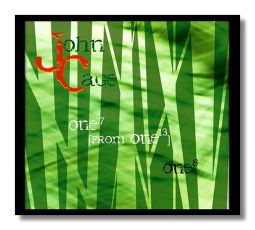
The Internet's Premier Classical Music Source
Related Links
- Cage Reviews
- Latest Reviews
- More Reviews
-
By Composer
-
Collections
DVD & Blu-ray
Books
Concert Reviews
Articles/Interviews
Software
Audio
Search Amazon
Recommended Links
Site News
 CD Review
CD Review
John Cage

Number Pieces
- One7 [from One13]
- One8
Anonymous cellist
OgreOgress UPC 643157358725 DDD 73:37
The so-called "number pieces," of which there are around fifty, occupied John Cage during the last years of his life. Generally speaking, the "main" number indicates how many performers are required. The superscript, when present, indicates how many works have been written for that number of performers. For example, One8, composed in 1991, was the eighth number piece written for one performer – in this case, cello. Indie label OgreOgress has been recording all of Cage's number pieces for strings or percussion. This is the fifth and last release in that series. Both works are for solo cello.
If I listened to John Cage's works long enough, I wonder if they would spoil my taste for more traditional modes of musical expression. Moving from one of Cage's late works to, say, a symphony by Rachmaninoff produces an almost brutal effect, at least as far as I am concerned. Cage is so frugal (not stingy) with notes, so objective, so dispassionate, that any music that follows is bound to seem wasteful and overblown. After you've scrubbed your bathroom and kitchen floors, you don't want to walk on them for days. That's pretty much how Cage's music makes me feel.
One8, which is over 43 minutes long, is typical of Cage's late work. Silences alternate with sounds until they become equally important. The sounds are not just individual notes, but sustained chords of three or four notes. These are effected by means of a special curved bow. Inevitably, producing chords in this manner causes irregularities, unevenness, or "distress" in the tonal quality. This is part of the music too. An astonishing variety of timbres is produced. Ethereal, ghostly, grating, dark, alarming, weird, pretty, and luminous all are words that come to mind during this recording of One8. There's even a point when you'll think that your tea kettle is whistling… assuming you have a tea kettle, that is. Also, Cage uses microtonality in this piece; chance processes were used to dictate that one or several notes in a chord are to be played sharp or flat… although just how sharp or flat is left to the discretion of the performer. Overall, this is a rewarding experience, but not in the way that Beethoven's "Eroica" Symphony is, of course.
One8 sounds like a Lucullan feast next to One7 [from One13]. The title (strictly speaking, not Cage's own) requires an explanation. When he died in 1992, Cage had not completed One13, which apparently was scored for cello with three prerecorded cellos. The score to One7 (completed in 1990) therefore was used as a mechanism to perform the extant material from One13. Or, as described in OgreOgress's booklet note, "One7 is performed exactly as written, but the sounds that appear are those Cage originally intended for the unfinished One13."
And what are those sounds? Well, they are the same pitch (an F sharp) repeated over and over again for 30 minutes. Boring, right? No, not at all, because there is variation in volume, duration, timbre, and in the silences between the repeated pitch. There are moments when the performer (intentionally? unintentionally?) audibly flattens or sharpens the pitch by something less than a quarter-tone, and when s/he does so, the effect is nothing less than provocative. Also, there are many ways of producing an F sharp on a cello. It is thereby proven that a lengthy piece of music in which just a single tone is used nevertheless can be interesting. Having listened to One7 [from One13], perhaps one feels that even One8 has too many notes. How does one listen to Arnold Schoenberg's Verklärte Nacht (for example) after an experience such as this one?
The performance itself disappears into the music. As for the engineering, its closeness fittingly amplifies the tonal zits and dimples in all their mind-blowing glory.
If you can't find this disc through your favorite retailer, go to http://ogreogress.home-page.org to find links to downloads, and to retailers who stock it.
Copyright © 2005, Raymond Tuttle




















